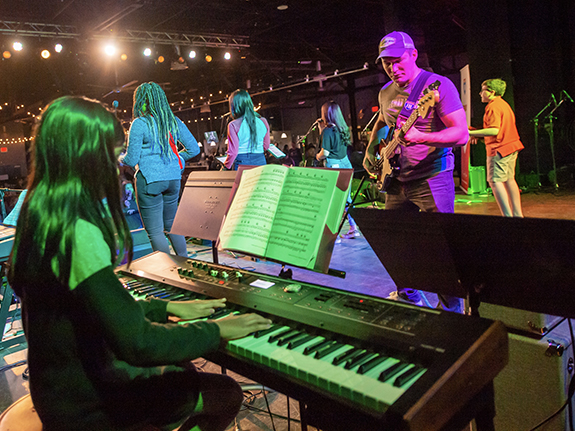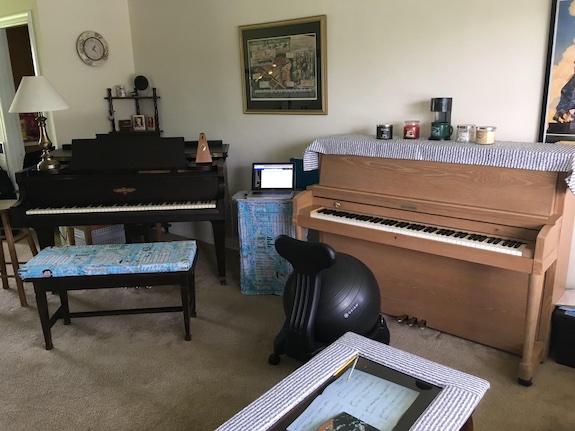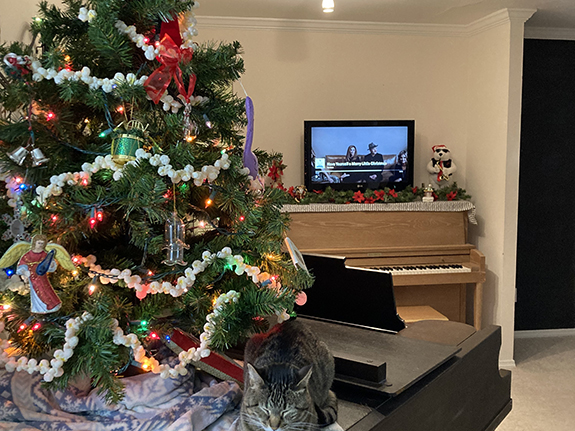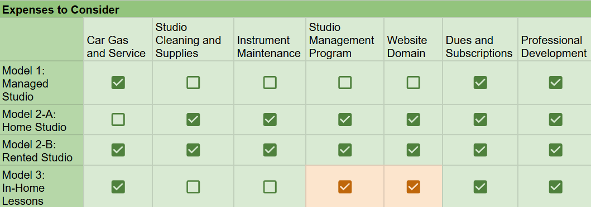In the Spotlight:
Stepping Stones for Emerging Careers: A Comparison of Select Studio Models
Verena Abufaiad and Michaela Boros
MTNA Business Digest, Volume 4, Issue 1
October 2024
Professional musicians’ careers are becoming increasingly multidisciplinary, and even within the field of music teaching, the possibilities for building a career may come in a variety of formats.
To aid new professionals in understanding their options, the authors provide an overview of four modalities of independent teaching: managed studios, individually owned businesses, driving to students’ residences for in-home lessons and online teaching. Understanding the variety of studio models will help new teachers find opportunities that best suit their professional and financial needs, especially in the early stages of their careers.
Overview
The four studio models were selected based on the authors’ research as the most representative approaches to independent teaching. For the purposes of this article, the research is based on piano teaching, but the models are applicable to all instruments. They are defined as follows:
- Managed studios—Organizations such as arts academies and piano stores that provide music instruction in facilities that accommodate more than one teacher and might even offer engagement with arts beyond music. They can be managed fully by administrative staff (“managed studio”) or in collaboration with their teachers (“managed with staff collaboration”).
- Individually-owned businesses—Businesses run by individual teachers who both teach and manage the administrative operations of a private studio, which may be at their house (“home studio”) or at a rented space (“rented studio”).
- In-home lessons—Businesses run by an individual teacher or an organization through which teachers drive to students’ residences for lessons.
- Online teaching—A studio model wherein the teacher and student communicate from different locations through a device such as a computer, tablet or phone. Ideally, both teacher and student also have access to and make use of their own instrument during lessons. Lessons may include the use of synchronous teaching (live instruction in real time) and asynchronous components (the exchange of time-differentiated elements to a shared virtual platform such as practice videos or written assignments). Online teaching may occur within the context of an arts academy or private studio.
These studio models may be used by teachers separately or in combination with each other. Teachers may also use them in combination with other job positions such as staff accompanist, church musician or university group piano instructor, or work outside of the field. Although selected as the focus of this research, these four studio models are not all-encompassing as other settings of piano teaching beyond the scope of this study may include public schools, private schools, universities or other scenarios. The pros and cons presented in this overview are also representative. Others may think differently about each of these points, which are a summary of the consensus perceived in existing literature, interviewee answers to direct questions about each studio model’s advantages and disadvantages and the lived experience of the authors.
The authors conducted live video interviews with six teachers and studio managers of diverse backgrounds and geographical locations—from a guitarist academy owner in South Carolina to an independent piano teacher renting studio space in Baton Rouge, Louisiana. These interviews provided real-time insight into current trends and building a career.
Altogether, the intention of this research is not to reinvent the wheel in studio model comparisons, but to provide a fresher look, especially post-COVID, of today’s studio teaching options available to new professionals. Discussion of each studio model will consist of an overview and list of pros and cons, followed by income and expense examples.
Studio Models
Model 1: Managed Studios
Multi-teacher studios such as arts academies and retail piano stores can be fully managed, with the administration controlling scheduling, communication, policies, marketing and space, and equipment upkeep (Model 1-A: Fully Managed Studio). Alternatively, managed studios can collaborate with their staff in aspects such as scheduling and communication (Model 1-B: Managed Studio with Staff Collaboration). In both settings, management’s role helps teachers focus on teaching. Other benefits for teachers might include a music library and/or recital hall at their disposal as well as opportunities for creative collaboration and networking with fellow instructors and continuing education. Startup investment for teachers is low, possibly including only a car or method of public transit to commute and personal books or materials they may wish to use in addition to any studio resources.
Managed studios may be nonprofit, with a primary mission of education, or they may be for profit, with dual goals of income and musical instruction (Thickstun 2015). Instructors at managed studios can be contracted as either employees or independent contractors and may be able to negotiate contract type along with pay rate. Employees receive Form W-2, their income and payroll taxes are withheld, and most expenses cannot be deducted. Independent contractors receive Form 1099, their taxes are not withheld, and their expenses can be deducted (Thickstun 2013/2014). In both cases, the teacher does not receive the full amount of what the student pays in tuition; the studio either retains a portion of each paycheck, or the teacher pays rent.
Other factors to consider include time spent commuting, vehicle expenses and wear, the necessity of bringing any specific materials not provided at the studio, or the chance that if sharing teaching space, disorganization and misplaced materials may occur if personal items are stored onsite. Although optimal teacher experience is contingent upon good administration, managed studios generally provide an easy, no-hassle way for teachers to quickly build a studio and gain experience in a professional, established setting.
Pros: Model 1 (Managed Studio)
- Requires low startup costs
- Provides professional, established setting
- Teachers focus on teaching while management handles advertising, recruitment, and upkeep
- Music library and/or recital venue may be provided
- Affords opportunities for creative collaboration, networking, continuing education, and professional development
- Depending on the studio, teachers may negotiate contract type and rates
Cons: Model 1 (Managed Studio)
- Lower teacher rates as studio takes a cut of teachers’ earnings
- Requires commute time and budgeting for vehicle expenses and wear
- Depending on the studio library (or lack thereof), teachers might have to carry books and other needed materials
- If sharing teaching rooms, there are higher chances for disorganization and misplaced materials
- Teachers may not have input in choosing quality instruments
- Optimal experience is contingent upon good management
Model 1-A: Fully Managed Studio
In a fully managed studio, the management has control over all administrative tasks for the studio, including lesson/class scheduling and most or all studio-wide recitals. Teachers may not be required to share their personal contact information with students, and students instead arrange all lessons and makeups with office management. This helps protect teachers’ work-life balance and to relieve them of the hassle of both scheduling and enforcing studio policies (Interview 2024). However, teachers might have less flexibility and independence, or find it harder to develop fruitful relationships with students if their only contact is during weekly lessons.
Additional Pros: Model 1-A
- The business, rather than individual teacher, enforces policies
- Can be easier to maintain professional boundaries
- Recitals and events are primarily organized by the management
Additional Cons: Model 1-A
- Greater management can be seen as restrictive for teachers
- Teachers have less flexibility to customize teaching schedule (holidays, for example)
- Can be harder to develop close personal relationships with students
Video tour of a managed studio with multiple teaching spaces.
Teacher Profile
Model 1-A: Fully Managed Studio
Name: Susan
Location: Ohio, small town
Income Sources: Owner and piano instructor for 128-student arts academy: beginner group piano classes, lessons in piano (c. 4 teachers) and other instruments, Musikgarten classes
Lesson Scheduling Tool:
- Google Drive
- Part-time desk manager
Studio Schedule:
- 13-week group classes
- Year-round lessons with 3 “enrichment” full studio group class weeks
Advertising Strategies:
- Facebook & website
- Sign near the county fairgrounds
- Word of mouth
Long-Term Goals: Continue establishing beginner group classes (begun 2021)
Advice for New Professionals:
“Even if you're not responsible for all of the scheduling, there is a personal touch [to teaching] as well as just teaching the music. Try to get involved within the studio, or just invest in yourselves, to make close connections even for the short time you might be there.”
Model 1-B: Managed Studio with Staff Collaboration
In a managed studio with staff collaboration, teachers and administration share duties such as scheduling and policy enforcement, providing teachers the opportunity to gain management experience in a supportive environment. For scheduling, teachers have access to a master schedule grid and may set their own schedules within studio parameters (i.e., certain days or time frames) once students are assigned by management. Teachers also maintain direct communication with clientele in person and by phone or email. For recitals and events, some may be planned by management, but with additional opportunities for teachers to creatively collaborate on events within the studio or community (summer camps, festivals, etc.).

Creative Performance Collaboration
Additional Pros: Model 1-B
- Teachers gain management skills through joint administration and teacher efforts in policy enforcement.
- Teachers enjoy freedom and independence in scheduling with some management (i.e., a shared Google calendar all teachers can edit)
- Some recitals and events are planned by management, with additional opportunities for teachers to organize their own events in creative collaboration (summer camps, festivals, etc.).
Additional Cons: Model 1-B
- Some administrative work is expected as teachers are required to adopt the studio scheduling system/software and policies
- Rescheduling lessons might be challenging as rooms are shared throughout the week
- Some studios may not offer a recital venue, in which case teachers must coordinate their own studio recital
Video tour of a managed studio with multiple teachers.
Teacher Profile
Model 1-B: Managed with Staff Collaboration
Name: Don
Location: South Carolina, suburban/urban
Income Sources: Owner and guitar instructor for arts academy with six branches: lessons in piano and other instruments, rock band group classes
Lesson Scheduling Tool:
- TeacherZone
- Full-time desk manager
Studio Schedule: Year-round with select one-week breaks
Advertising Strategies:
- Word of mouth
- Google AdWords
- Targeted social media: back to school and holiday seasons
Long-Term Goals:
- Two pianos in every room
- Roof sunlights
Advice for New Professionals:
“You get what you put into it. The teachers that succeed at our school are the ones who care deeply about what they're doing and participate in what we do. Team players.”
Regardless of whether administrative responsibility is handled fully by management or in collaboration with staff, teaching in a managed studio offers new professionals the opportunity to quickly build a studio, gain experience with administrative support, and work in an established, professional setting as they shape their careers.
Model 2: Individually Owned Businesses
Individually owned businesses are run by individual teachers who both teach and manage the administrative operations of a private studio, which is located at their house (Model 2-A: Home Studio) or a rented space (Model 2-B: Rented Studio). In both cases, teachers enjoy complete autonomy over schedules, policies, tuition, space, equipment and instruments, curriculum, recitals and events.
Opening an individually owned business requires significant investment. Teachers must own a home, live in a rental property that permits teaching, or rent a separate teaching space. Additional investments include at least one instrument (or two), a music library, cleaning and maintenance of instruments and space, a studio management program such as My Music Staff (if desired), and a vehicle if commuting to a separate teaching studio. Independent studio owners are also encouraged to purchase the appropriate insurance (How 2024), register their business ((MTNA)(sole proprietorship or LLC are the two most applicable options), and ensure they follow correct procedures for paying taxes (Walker 2022) MTNA Business Resources (LINK to Business Resources landing page). Depending on the location, zoning and covenant restrictions should be investigated before opening the studio. Click here for more information.
Individual business owners receive 100% of the tuition income. They can reserve payment for themselves along with budgeting for initial and regular expenses and long-term goals such as a new piano, purchasing a separate teaching space, or starting additional programs such as group classes or hiring additional teachers. Although individual business owners enjoy autonomy over all aspects of studio management, having full responsibility over all business-related matters can be overwhelming and impose a real challenge in balancing studio management and teaching. In addition, Model 2 teachers may find very limited opportunities for professional collaborations with other musicians and for participation in more diverse events.
Pros: Model 2
- Teachers have full autonomy over all aspects of studio management (tuition, policies, schedule)
- Teachers set their own rates and decide what to do with 100% of the income (investment strategies)
- Affords consistent paycheck (Interview 2024)
- Studio setup can be fully customized
- Teachers have freedom to experiment with a creative curriculum, recital requirements, and other events
- Teachers enjoy the convenience of interacting with parents, being able to communicate directly with them without having to go through a business office (Bowen 2020)
Cons: Model 2
- Teachers may feel isolated from professional colleagues and events
- Providing students diverse, collaborative experiences such as chamber music is a challenge (Bowen 2020)
- Having full responsibility over administration and bookkeeping work can be overwhelming—“the advantage of complete control is also a disadvantage” (Interview 2024)
- Teachers have full responsibility over piano maintenance and studio cleanliness
- Keeping a healthy balance between administrative work and teaching can be difficult
- With managing and teaching duties altogether, practice time is limited (Interview 2024)
Model 2-A: Home Studio
In this model, a private studio is located in the teacher’s home residence.
Additional Pros: Model 2-A
- There are no additional fees (rent or utilities)
- There is no commuting (or vehicle expenses)
- All books and materials are at hand
Additional Cons: Model 2-A
- Controlling optimal teaching environment with pets, other family members, constant traffic of students in personal home can be difficult (Bowen 2020)
- There is no physical separation between work and home, so teachers might struggle to detach and relax after hours (Interview 2024)
- Parking and designating waiting room spaces may be challenging
Teacher Profile
Model 2-A: Home Studio
Name: Cindy
Location: Missouri, suburban/urban
Income Sources: Home studio, 61 students
Lesson Scheduling Tool: My Music Staff
Studio Schedule: 16-week semesters including 1–2 themed group lessons, flexible summer
Advertising Strategies:
- Word of mouth
- Local MTNA teacher list
- $20 discount for second siblings
Long-Term Goals:
- Stay in independent teaching
- Purchase second grand piano
- Retirement
Advice for New Professionals:
“Have patience with building your studio, because it takes time. The first year I had 10–15 students. By the second year I had 25. By the third year I had about 40. You can’t just jump in and have a 60-student studio immediately.
Protect your off days. Even when I only had 15 students, I was doing other jobs on the side, seven days a week. The fact that I didn’t have an off day was draining.”
 |
 |
| Instrument placement in home studio |
Customized virtual lesson setup |
Model 2-B: Rented Studio
In this model, the teacher runs a private studio in a rented space outside the home, such as an office building, church, or shopping center.
Additional Pros: Model 2-B
- Separation between personal and teaching spaces protects work-home balance
- If space permits, group classes and group piano sessions can create more income and student interaction
- Allows for partnership with another teacher and for shared responsibilities
Additional Cons: Model 2-B
- When choosing a location, teacher must consider commute time, budget, size, and safety needs (Bowen 2020)
- Regular expenses continue even if summer enrollment is low (Bowen 2020)
- There may be issues with neighbors and building outside your control (Interview 2024)
Teacher Profile
Model 2-B: Rented Studio
Name: Sarah
Location: Louisiana, suburban
Income Sources:
- Rented studio, 15 students
- Part-time remote administrative work with The Frances Clark Center
Lesson Scheduling Tool: My Music Staff
Studio Schedule: 16 lessons per semester, flexible summer
Advertising Strategies:
- Word of mouth
- Referral discount
- Free first lesson
Long-Term Goals: Start an adult group class on Zoom
Advice for New Professionals:
“Rental agents will try to pressure you into renting that day. Be careful not to jump just because the price is low...
I think at my age, it's about learning what you do and don't want so that you can make adjustments for yourself.”
Regardless of whether teachers running individually owned businesses choose to teach from their home or a separate location, this is an excellent option for those who are establishing themselves in an area, feel up to the challenge of complete control over both curricular and business aspects, desire to increase their revenue stream, and are in a financial position to make this happen effectively.
Model 3: In-Home Lessons
In-home lesson businesses are run by an individual teacher or an organization through which instructors drive to students’ residences to teach. The startup investment is low, primarily consisting of a car to commute as well as books and materials. Teachers become acquainted with their geographical area, which helps them to optimize their commutes and to gain familiarity with other possible professional opportunities—affluent neighborhoods, potential recital venues and other local music studios (competition or potential employment!). The ease of in-home lessons for parents renders conditions ideal for high retention rates and multiple siblings taking lessons. This setting also facilitates development of close, personal connection with students, parents, and family. Teachers can also be directly influential in creating an optimal home practice environment (minimal distractions, instrument quality, and bench placement).
If teachers operate an independent in-home lesson business, they receive 100% of income from tuition and can reserve payment for themselves along with budgeting for initial and regular expenses (notably gas and vehicle wear), taxes and long-term goals like establishing a home studio or hiring additional teachers for their in-home lesson business. If teachers work for an in-home lesson organization, the pay rate may be lower, but they receive administrative support for billing, advertising, and recital planning.
Careful groundwork planning is required for in-home lessons to be profitable in terms of commute time, vehicle expenses and wear, and appropriate tuition rates. Teachers must carry all needed materials to each student’s home, and be courageous to speak up about any requested changes in the environment. Creating collaborative opportunities both for teachers professionally and within their studio can be challenging because in-home lessons lack a fixed location for gathering. In addition, students might not want to commute past a certain distance to come together for masterclasses, group lessons, or recitals. Despite these challenges, in-home lessons afford teachers the opportunity to teach with full or supported independence without significant investment.
Pros: Model 3
- Requires low startup costs (Interview 2024)
- Helps in protecting home-work balance
- Families appreciate the convenience, leading to the enrollment of multiple siblings and higher retention rates (Interview 2024).
- The convenience factor for parents may command a premium tuition rate, leading to higher income
- Familiarity with teaching area/neighborhood can result in new opportunities (Interview 2024)
- Teachers facilitate optimal home practice set-up and environment (Sorenson 2024)
- Teachers develop close, personal connection with students, parents, and families (Interview 2024)
Cons: Model 3
- Requires commute time and budgeting for vehicle expenses and wear
- Transition time between lessons can be very inefficient due to constant commuting, resulting in less students and potentially less income
- Driving time may become draining or frustrating
- Tuition rates must be appropriately high for profitable income (Interview 2024)
- Teacher must carry books and other needed materials
- Optimal experience is contingent upon students’ home environment, requiring teachers to be confident and courageous to request needed changes
- Collaborative opportunities for teachers and/or students are limited
Teacher Profile
Model 3: In-Home Lessons
Name: Azusa
Location:
- Former: Florida, urban
- Current: Kentucky, small town
Income Sources:
Lesson Scheduling Tool:
- Former: none
- Current: My Music Staff
Studio Schedule:
- Former: year-round, c. 36 weeks
Advertising Strategies:
- Word of mouth
- Website
- Community concerts: banners, program book ads, and simply presence and performing
Long-Term Goals: Build a full teaching studio in the area
Advice for New Professionals:
“Look at how much driving you're going to end up doing, and how much to then add to your tuition. And I think at the beginning, it's smarter to set, ‘I'm not going out of this area, period,’ unless you know you love to drive…
I think you must know your limits, what's acceptable and what's not for you. I think it's different from teacher to teacher.”
Model 4: Online Lessons
Although online teaching has occurred since the late-20th century with the increased accessibility of technology and the internet, circumstances of the global pandemic of 2020 forced the majority of piano instructors to adapt to teaching virtual lessons—a skill that remains at their disposal to use as desired. In addition to a fully online studio, virtual teaching can also be incorporated at managed studios or individual owned businesses in a variety of ways such as makeup lessons, extenuating circumstances, specific courses and reaching broader communities.
- Sarah, who operates a Model 2-B Rented Studio in Baton Rouge, Louisiana, offers Zoom lessons as makeups or in place of face-to-face instruction during regular lesson time if students are ill (Interview 2024).
- During grad school in South Carolina, Azusa utilized Model 3 In-Home Lessons to commute to her students in Florida monthly and taught online in the intervening weeks (Interview 2024).
- Paola in Ann Arbor, Michigan, maintains an in-person Model 2-A Home Studio and also offers a fully online group piano course for adult beginners (Savvidou 2024).
- Lady, also based in South Carolina, works part-time at a Model 1-B Studio (Managed with Staff Collaboration) and teaches philanthropic online lessons to family and friends to help them achieve personal goals such as performance in church or a concert of hymn arrangements. She plans to expand this initiative and to start a studio with both in-person lessons and online instruction to reach broader communities with limited access to piano lessons, such as in the Philippines, her native country (Interview 2024).
Startup investment to teach online can be low, with students and teachers requiring for a basic setup simply a piano or digital keyboard, a computer or tablet capable of video calling, the appropriate books and other lesson materials, and a method of taking practice notes (Google Doc, email, etc.). Moreover, online teaching easily provides opportunities for the inclusion of technology-related study in lessons (such as GarageBand and BandLab), and the flexibility to incorporate synchronous and asynchronous learning. Neither teachers nor students have to commute, and with this modality teachers can even retain students from previous locations after moving.
Students who perform well in online lessons can become very independent and develop strong ownership of their study. However, other students might find that lack of face-to-face interaction makes it difficult to connect emotionally and grow in learning. In addition, parents might struggle to see the financial value of online lessons, especially because optimal experience is contingent upon reliable internet connection and technology and performance opportunities are more limited. However, with focus on good pedagogy and use of technology and resources with which they are comfortable, teachers can find online lessons to be both flexible and effective.
Pros: Model 4
- Does not require commuting from either teacher or student, affording time efficiency in switching from lesson to lesson
- Increases teachers’ relevance, adaptability and diversity
- The inclusion of technology-related learning is done with ease, such as using music production programs like GarageBand and BandLab (Interview 2024)
- Strengthens student independence and ownership of learning (Interview 2024)
- Provides the opportunity for teachers to retain students in case of moving away for a new degree or job
- Allows for hybrid, synchronous, and asynchronous teaching/learning modes
Cons: Model 4
- Optimal experience is contingent upon reliable internet connection and technology
- Teachers must stay updated on continuously advancing technology and breadth of resources
- Parents might struggle to see equal value in online lessons
- Lack of face-to-face interaction can block emotional connection and students’ growth
- Exclusively online teaching may limit performance possibilities
- Live duets are not possible through standard platforms
Even if they choose not to embark upon teaching a fully online studio, new professionals can benefit from familiarity with online teaching as a relevant, flexible skill in today’s field, whether they offer online makeup lessons, teach remotely in special circumstances, offer specific virtual courses, or seek to expand to wider communities.
Financial Profiles
The following tables compare income and expenses for different studio models. These profiles are provided as illustrations for the financial and professional viability of the following studio models:
- Model 1: Managed Studio
- Model 2-A: Home Studio
- Model 2-B: Rented Studio
- Model 3: In-Home Lessons
(Model 4: Online Teaching was not included because this project focused on the flexible options that Model 4 provides within the context of other types of teaching.)
Incomes were calculated based on real rates provided by teachers in their Spring 2024 interviews. Incomes are based on a 25-hour teaching week (Monday–Friday, 3:00–8:00 p.m.) at 48 weeks per year (four weeks off including Thanksgiving, Christmas and New Year’s holidays and one spring or summer break). However, more teaching could certainly be done if desired. These examples may serve as starting points for specific calculations of income, startup needs, and general expenses. Income and expenses will vary by teacher and region and should be researched carefully along with tax requirements in consultation with professionals as appropriate.
Model 1: Managed Studio (South Carolina)
- Income:
- Startup needs:
- Expenses to consider:
Model 2-A: Home Studio (Missouri)
- Income:
- Startup needs:
- Basic recurring expenses:
Model 2-B: Rented Studio (Louisiana)
- Income:
- Startup needs:
- Basic recurring expenses:
Model 3: In-Home Lessons (Kentucky)
- Income:
- Startup needs:
- Basic recurring expenses:

Table 1: Comparison of startup needs**

Table 2: Comparison of basic recurring expenses**
*For tax information, see “A Brief Tax Guide for the Independent Music Teacher,” other MTNA Business Resources and IRS information such as this webpage for how to list tax deductions, best practices and filing taxes.
**Orange checkmark indicates possibly, rather than likely, applicable. Table 1: music library may be fully provided by the studio. Table 2: if working for an in-home lesson business run by an organization, teachers may not need to cover these expenses.
Conclusion
Familiarity with various studio models will help new teachers find opportunities that best suit their professional and financial needs, especially in the early stages of their careers. In addition to existing literature such as books and manuals on independent teaching by Beth Gigante Klingenstein, NCTM, and others, articles and blog posts on different studio models such as those by Karen Thickstun, NCTM, online business resources such as those published by MTNA, and multimedia resources such as Andrea Miller’s Music Studio Startup or the Frances Clark Center’s course A Pianist’s Guide to Studio Management, interviews with current professionals in the field provide real-life insight and tips on the realities of teaching in each studio model.
Teachers may opt for a Model 1 studio, where management eases the burden of providing space, administrative duties, recruitment, and other planning either almost entirely (Model 1-A: Fully Managed Studio) or in collaboration with teachers (Model 1-B: Managed with Staff Collaboration). Income may overall be lower, but associated startup investment and maintenance costs similarly follow suit. This model also provides opportunities for collaboration, mentorship, and easily gaining professional experience.
A Model 2 studio provides teachers full flexibility in creating their studio, whether from their home (Model 2-A: Home Studio) or an alternative location (Model 2-B: Rented Studio). Teachers collect 100% of income, but also must manage their own bookkeeping and defray a percentage of their earnings to studio expenses. Opportunities for professional collaboration may be harder to come by due to the more isolated nature of this studio model.
In Model 3: In-Home Lessons, whether teachers provide lessons in students’ homes as an individual business owner or as part of an organization with administrative support, this model affords a convenient situation for parents and low startup investment for teachers. The total income retained as well as collaborative opportunities may vary for each individual situation.
Lastly, even if teachers do not run a fully online studio, maximizing skills learned during the global pandemic of 2020 offers teachers flexibility in makeup lessons or extenuating circumstances, or opportunities for teaching specific online courses or reaching wider communities (Model 4: Online Teaching).
There is no “right” or “wrong” studio model, and changes in teaching situations are inevitable in each teacher’s professional career. However, understanding these studio model options, and projected incomes compared to current opportunities in their area, can aid teachers in deciding, step by step, what studio model is the best fit for their situations and career goals.
Resources
Books and Manuals on Independent Teaching
Music Teachers National Association. n.d. "Business Options for Music Teachers Setting Up a Studio."
https://www.mtna.org/downloads/MembersOnly/25247_StartUp.pdf.
Klingenstein, Beth Gigante. The Independent Piano Teacher’s Studio Handbook. Hal Leonard Corporation, 2009.
Osborn, Rebecca. 2004. The Private Music Instruction Manual: A Guide for the Independent Music
Educator. Trafford.
Studio Model Overviews
Bowen, Isabel. 2020. “Teaching from Home: A Very Candid Account of the Pros and Cons, Part 1:
Teaching at an Academy.” BowenPianoStudio.com, September 13. https://bowenpianostudio.com/blog/fddp8s72m8j267gy2ns6ls9h7ag3g5.
_______. 2020. “Teaching from Home: A Very Candid Account of the Pros and Cons, Part 2: The
Particularities of Teaching for a Nonprofit.” BowenPianoStudio.com, September 13. https://bowenpianostudio.com/blog/s78hnydn6gs344ht9hmd3b6canbkcy.
_______. 2020.“Teaching from Home: A Very Candid Account of the Pros and Cons, Part 3:
Establishing your Studio Within a Church.” BowenPianoStudio.com, September 13. https://bowenpianostudio.com/blog/3dash3mzk2k5klkbp4jepp5yzdf54l.
_______. 2020. “Teaching from Home: A Very Candid Account of the Pros and Cons, Part 4: Renting
Your Own Space to Teach.” BowenPianoStudio.com, September 13.
https://bowenpianostudio.com/blog/63yxyyyc4w6tdtrz7yjwhj355ltmfy.
_______. 2020. “Teaching from Home: A Very Candid Account of the Pros and Cons, Part 5:
Teaching from a Home Studio.” BowenPianoStudio.com, September 13.
https://bowenpianostudio.com/blog/a2ap6489txa5btt8y9fy2tzwthpjgp.
_______. 2022. “Teaching from Home: A Very Candid Account of the Pros and Cons, Part 6: No
Longer Teaching from Home—When is it Time to Move Out of Your Home Studio?”
BowenPianoStudio.com, July 4. https://bowenpianostudio.com/blog/pianoforteacherscom/blog.
Crappell, Courtney. 2010. “Music Academy Or Private Studio: Where Should I Teach?” American
Music Teacher, December/January 2010/2011.
https://www.proquest.com/openview/f8e3f3687519d9aa11c179c4fad9032a/1?pq-orgsite=gscholar&cbl=40811.
Sorenson, Grace. “Collegiate Essay Honorable Mention: There’s No Place Like Home: The
Benefits of an At-Home Lesson.” Piano Magazine, Winter 2023–2024.
https://pianoinspires.com/article/collegiate-essay-honorable-mention-theres-no-place-like-home-the-benefits-of-an-at-home-lesson/.
Thickstun, Karen. “It’s All Your Business: Having it All Without Doing it All,” American Music
Teacher, April/May, 2008.
https://www.thefreelibrary.com/It%27s+all+your+business%3a+having+it+all+without+doing+it+all.-a0178083181.
_______. 2013. "Think Outside the Home, Part 1: Teaching Opportunities and Options, Part 1
Independent Contractor or Employee.” American Music Teacher, December/January
2013/2014.
https://www.mtna.org/MTNA/Business_Resources/Studio_Resources/Structure_Loc/2013_DJ.aspx.
_______. 2014. “Think Outside The Home, Part 2: Teaching Options And Opportunities Part 2:
Online…And Onward.” American Music Teacher, April/May 2014.
https://www.mtna.org/MTNA/Business_Resources/Studio_Resources/Structure_Loc/2014_AM.aspx.
_______. 2014. “Think Outside The Home, Part 3: Teaching Options And Opportunities Online…And
Onward.” American Music Teacher, August/September 2014.
https://www.mtna.org/MTNA/Business_Resources/Studio_Resources/Structure_Loc/2014_AS.aspx.
_______. 2014. “Think Outside The Home, Part 4: Teaching Options And Opportunities Teaching At A
For-Profit Organization.” American Music Teacher, December/January 2014/2015. https://www.mtna.org/MTNA/Business_Resources/Studio_Resources/Structure_Loc/2014_DJ.aspx.
_______. 2015. “Think Outside The Home, Part 5: Teaching Options And Opportunities Teaching At a
Non-Profit Organization.” American Music Teacher, April/May 2015. https://www.mtna.org/MTNA/Business_Resources/Studio_Resources/Structure_Loc/2015_AM.aspx.
_______. 2015. Think Outside The Home, Part 6: Teaching Options And Opportunities Teaching In
Students' Homes…” American Music Teacher, August/September 2015.
https://www.mtna.org/MTNA/Business_Resources/Studio_Resources/Structure_Loc/2015_AS.aspx.
_______. 2015. “Think Outside The Home, Part 7: Teaching Options And Opportunities "The Middle
Man.” American Music Teacher, December/January 2015/2016.
https://www.mtna.org/MTNA/Business_Resources/Studio_Resources/Structure_Loc/2015_DJ.aspx .
_______. 2016. “Think Outside The Home, Part 8: Teaching Options And Opportunities Forks In The
Road.” American Music Teacher, April/May 2016.
https://www.mtna.org/MTNA/Business_Resources/Studio_Resources/Structure_Loc/2016_AM.aspx .
Business
Gilligan, T. Scott. n.d. “Buying and Selling Music Studios.” MTNA Business Resources.
https://www.mtna.org/downloads/MembersOnly/Buying%20and%20Selling%20a%20Studio.pdf.
How, Deborah. 2023. “In the Spotlight: Starting a Music School?” MTNA Business Digest, April 2023.
https://www.mtna.org/MTNA/Business_Resources/Studio_Resources/Structure_Loc/Starting.aspx.
Jordan, Martha Baker. 2004. Practical Piano Pedagogy. Warner Bros Publications.
Klingenstein, Beth Gigante. 2022. "Legal Landscape: Business Structure Options for Music Teachers,"
MTNA Business Digest, July 2022.
https://www.mtna.org/MTNA/Business_Resources/Legal_Resources/Resources/Structure_Options.aspx.
Music Teachers National Association. n.d. “Zoning.” https://www.mtna.org/MTNA/Business_Resources/Legal_Resources/Zoning/Zoning.aspx.
Entrepreneurship
Allen, Monica and Jessica Mellott with Rebecca Grooms Johnson, Ed. 2009. “Starting A Studio: What,
Where, and How?” Clavier Companion January 2009.
https://pianoinspires.com/article/starting-a-studio-what-where-and-how/.
Thickstun, Karen. 2022. “Put Me In, Coach!” American Music Teacher, April/May 2022.
https://www.mtna.org/MTNA/Business_Resources/Career_Development/Development/2022_AM.aspx.
_______. “Put Me In, Coach!” 2022. American Music Teacher, August/September 2022.
https://www.mtna.org/MTNA/Business_Resources/Career_Development/Development/2022_AS.aspx.
Finance/Fundraising
Smith, Heather. 2024. “In the Spotlight: Financial Planning for Music Teachers at Different Stages of
Life.” MTNA Business Digest, April 2024.
https://www.mtna.org/MTNA/Business_Resources/Finance/Retirement/Financial_Planning.aspx.
Stephenson, Tim. 2023. “Top Five: Top Five Ways to Fund a Start-Up Business.” MTNA Business
Digest, January 2023.
https://www.mtna.org/MTNA/Business_Resources/Finance/Fundraising/Startup.aspx.
Insurance
How, Deborah H. 2023. “Legal Landscape: Business Insurance 101 for Music Teachers, Part 1.”
MTNA Business Digest, October 2023.
https://www.mtna.org/MTNA/Business_Resources/Finance/Insurance/Insurance_101_1.aspx .
_______. 2024. “Legal Landscape: Business Insurance 101 for Music Teachers, Part 2.”
MTNA Business Digest, January 2024. https://www.mtna.org/MTNA/Business_Resources/Finance/Insurance/Insurance_101_2.aspx..
_______. 2024. “Legal Landscape: Business Insurance 101 for Music Teachers, Part 3.”
MTNA Business Digest, April 2024.
https://www.mtna.org/MTNA/Business_Resources/Finance/Insurance/Insurance_101_3.
aspx.
_______. 2024. “Legal Landscape: Business Insurance 101 for Music Teachers, Part 4.”
MTNA Business Digest, July 2024.
https://www.mtna.org/MTNA/Business_Resources/Finance/Insurance/Insurance_101_4.
aspx.
Legal Resources
Gilligan, T. Scott. n.d. “Protecting Your Business Name.” https://www.mtna.org/downloads/MembersOnly/19486_BusinessName.pdf.
_______. n.d. “Registration of Fictitious Names under State Law.” https://www.mtna.org/downloads/MembersOnly/19485_TradeNamesLaw.pdf.
Music Teachers National Association. n.d. https://www.mtna.org/MTNA/JoinAndRenew/Membership/Members_Only/Legal.aspx.
Taxes
Music Teachers National Association. n.d. “A Brief Tax Guide for the Independent Music Teacher.” https://www.mtna.org/MTNA/Business_Resources/Finance/Taxes/Guide.aspx.
Walker, David. 2022. “Legal Landscape: Taxes for Small Business Owners (Including Independent
Music Studios/Schools).” MTNA Business Digest, October 2022.
https://www.mtna.org/MTNA/Business_Resources/Finance/Taxes/Small_Business.aspx.
Technology
Casarotti, João Paulo. 2023. “Technology Tips and Tools: Back to the Future: Effective Visual
Communication and the Interdependence of In-Person, Online and Hybrid Piano
Instructions.” MTNA Business Digest, July 2023.
https://www.mtna.org/MTNA/Business_Resources/Studio_Resources/Online/Hybrid.aspx.
Greene, Ryan. 2024. “Top 5: Top 5 Tech Hacks for the Modern Studio.” MTNA Business Digest,
January 2024. https://www.mtna.org/MTNA/Business_Resources/Studio_Resources/Online/TechHacks.aspx.
Savvidou, Paola. n.d. Accessed July 27, 2024. https://www.paolasavvidou.com.
Teacher Profiles
Thickstun, Karen. 2012. “Smart, Single, Successful! Making A Living As An Independent Music
Teacher.” American Music Teacher, February/March 2012.
https://www.mtna.org/MTNA/Business_Resources/Entrepreneurism/2012_FM.aspx.
_______. 2011. “Smart, Single, Successful! Smart, Single, Successful! Effective Business
Strategies For Young Professionals.” American Music Teacher, October/November
2011. https://www.mtna.org/MTNA/Business_Resources/Entrepreneurism/2011_ON.aspx.
_______. 2010. “Earn $100,000 As An Independent Teacher? Yes!” American Music Teacher, April/May 2010. https://www.mtna.org/MTNA/Business_Resources/Entrepreneurism/2010_AM.aspx.
Webinars and Multimedia
Greene, Ryan. 2023. 10 Tech Hacks for the Modern Studio. Music Teachers National Association Webinar. August 18.
https://www.mtna.org/MTNA/JoinandRenew/Membership/Members_Only/MTNA_Webinars/Webinars_8.aspx#10Tech.
How, Deborah, and Heather Smith. 2022. "A Pianist’s Guide to Studio Management" The Frances Clark
Center Online course. 2022. https://pianoinspires.com/course/studio-management/.
Jutras, Pete. 2018. "The Future of Music Teaching". Music Teachers National Association Webinar. November 30. https://www.mtna.org/MTNA/JoinAndRenew/Membership/Members_Only/MTNA_Webinars/Webinars_3.aspx#future.
Kuuskoski, Jonathan. 2019. "Ready to Launch: Entrepreneurial Tools for Your Studio." Music Teachers National Association Webinar. February 15. https://www.mtna.org/MTNA/JoinAndRenew/Membership/Members_Only/MTNA_Webinars/Webinars_4.aspx#entrepreneur .
Miller, Andrea. n.d. Music Studio Startup Podcast. Accessed June 15, 2024. https://www.musicstudiostartup.com/.
_______. 2021. "SENSEational Studio Branding: Connecting With Students Through All the
Senses." Music Teachers National Association Webinar. January 22.
https://www.mtna.org/MTNA/JoinAndRenew/Membership/Members_Only/MTNA_Webinars/Webinars_6.aspx#senses.
Miller, Andrea and Jennifer Walschap. 2022. "Choosing a Business Model to Match Your Vision." Music Teachers National Association Webinar. June 24.
https://www.mtna.org/MTNA/JoinAndRenew/Membership/Members_Only/MTNA_Webinars/Webinars_7.aspx#model.
Smith, Heather. 2021. "Licenses, Taxes & Budgeting: A Financial Overview for Music Teachers."
Music Teachers National Association Webinar. September 10.
https://www.mtna.org/MTNA/JoinAndRenew/Membership/Members_Only/MTNA_Webinars/Webinars_6.aspx#Financial.
Thickstun, Karen. 2018. "Business Planning for the Independent Music Teacher—Part 1: 'The Big
Picture.'" Music Teachers National Association Webinar. April 13.
https://www.mtna.org/MTNA/JoinAndRenew/Membership/Members_Only/MTNA_Webinars/Webinars_3.aspx#biz1.
_______. 2018. "Business Planning for the Independent Music Teacher—Part 2: 'Nuts and
Bolts,'" Music Teachers National Association Webinar. May 11.
https://www.mtna.org/MTNA/JoinAndRenew/Membership/Members_Only/MTNA_Webinars/Webinars_3.aspx#biz2.

Verena Abufaiad, DMA, is a pianist and educator who serves as piano program director at Freeway Music in Blythewood, South Carolina. She was the recipient of the 2023 MTNA e-Journal Article of the Year Award.

Michaela Boros, DMA, University of South Carolina, is The Frances Clark Center’s program operations manager and associate director of The Piano Conference: NCKP 2025. She also teaches piano at Freeway Music in Blythewood, South Carolina.